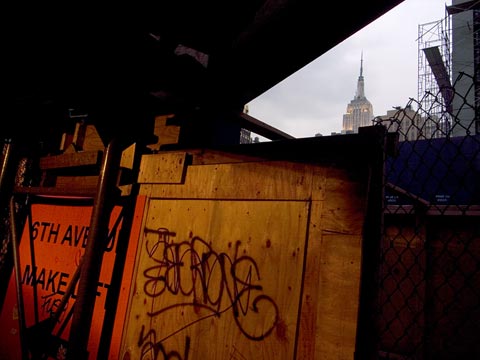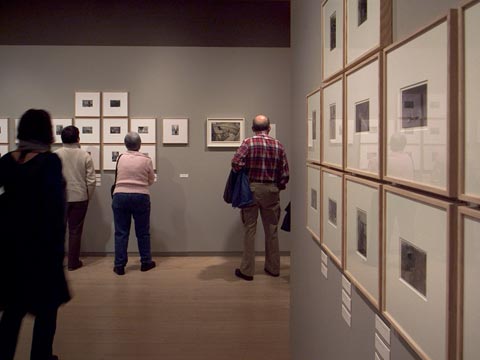New York/Cartier-Bresson Exhibit

The Empire State Building from 6th Avenue and 42nd Street (near ICP)
Given the current preference for very large exhibition prints, the Henri Cartier-Bresson exhibit at ICP is exceptional in that most of the prints are no more than 9x12 centimeters--smaller than 4x5 inches. The prints were originally made for a scrapbook that Cartier-Bresson created to present an overview of his work in preparation for an exhibit at the Museum of Modern Art in 1946. His work was already well-known, but his whereabouts, just at the end of World War II was not. MoMA had begun organizing a posthumous exhibition when Cartier-Bresson emerged from hiding in France after his escape from a German prisoner-of-war camp.
The prints were originally pasted in a large scrapbook bought in New York and kept by Cartier-Bresson until the book's pages of cheap paper began to fall apart. The ICP exhibit is a reconstruction of the book--not the layout of the pages--but the sequence of images. In many cases, the sequence includes outtakes of famous images taken seconds or minutes apart. Choosing "the best" is not always immediately obvious, and seeing multiples versions of the same scene changes my way of thinking about these images. I am struck by the cinematic nature of his work--these are like frames of a movie--slices of life as it unfolded before him.
I've always thought of Cartier-Bresson first in formal terms, his way of framing and composing, which was groundbreaking, and although he has been described as a surrealist, I've never really seen much in that. These are purely photographic juxtapositions that lend a surreal aspect to some of the images, and such visual playfulness appears, perhaps, less startling now. On the other had, this exhibit reminds one that Cartier-Bresson was often working on assignment, and that stories were important to his way of working. Rather than random note taking, Cartier-Bresson was seeking a coherent, if idiosyncratic, narrative in his work.

Henri Cartier-Bresson's Scrapbook: Photographs, 1932-46, ICP
A few comments on the exhibition itself. Because the prints are so small, bring reading glasses, or even a magnifying glass. I saw a man with one while I was there. Make an effort to go when the museum is less crowded. Since people are almost pressing their noses to the prints, there's not much room to share with your immediate neighbors. On the Saturday I was there, the place was jammed, which I consider remarkable for such a serious minded exhibition. And finally, as I've complained before, you are not allowed to use a camera in the ICP galleries. I'm sure they have their reasons, but the ban on cameras seems particularly ungenerous in the context of Cartier-Bresson, a cat burglar with a Leica. The photo above was taken with my little black Ricoh spy camera.

0 Comments:
Post a Comment
Links to this post:
Create a Link
<< Home